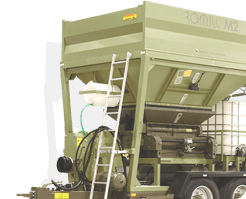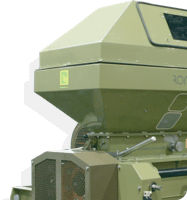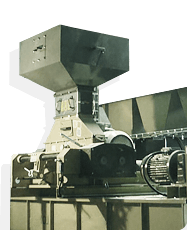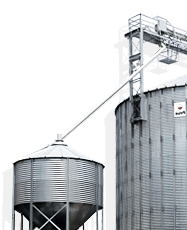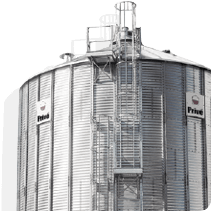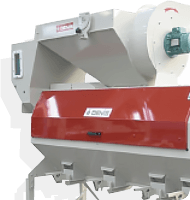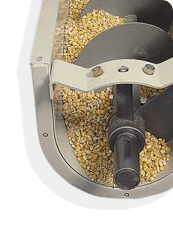
Conservation of wet crushed maize grain
Silage of wet mechanically treated wet grains, whether crushed or roughly cracked ones, is currently more common than divided harvest of the “LKS“ or “CCM“ maize. Average moisture of maize grains ranges from 30 to 35 %. The energy density in dry substance is 9-9.2 MJ NEL. Preserved wet maize grain can have up to the 98 % digestibility. Therefore it is advisable also for fattening of pigs, high-efficiency dairy cows and intensive fattening of cattle. Wet maize grains are to be used up as fodder in the form of TMR so that due to high tastiness there would be no selective receiving and unbalance of the feed ration. 3-7 kg of ensiled grains per day can be included in the feed ration. From the economic point of view, the method of conservation of wet maize grains is a path to reduction of costs on fodder production because the final drying is not required and the maize has also the yield per hectare higher up by 50-100 % than traditional cereals. At ensiling the impact of adverse weather at the harvest is reduced and the maize harvest-time lengthens. Prerequisites for the harvest of maize grains even in nontraditional regions are created, namely also in the territories with the height of 500 m above sea level. Manufacturing organization is eliminated from the process of production of fodder mixtures thereby costs on production of fodder mixture are reduced.
Requirements for storage space are reduced as well as. The fodder is tasty and animals like to receive it. In comparison with dry grain, wet grain has higher nutritional value and better digestibility of organic matter. Utilization of soluble nitrogen of the entire feed ration is increased by ensiling and the structure of mixed feed ration is improved. At ensiling of wet mechanically treated grains, the maize is harvested with the 60-65 % content of dry matter. The best harvest-time with respect to work of picker-sheller and optimum output power of mechanical equipment for the grain treatment is the 63-65 % content of dry matter. At the 40% moisture a black spot begins to be created at the maize grain and a clod forms from crushed material. In ensiled crushed maize grain at the 63.5 % content of dry matter, the pH value decreases fast enough to the level of 3.75, whereas the titratable acidity is less than 1 000 mg KOH. The fermentation acid content in dry matter ranges from 1 to 2.5 %, which is twice to three times less than at “LKS“. On that ground it is necessary to stabilize the reduced fermentation by a chemical preparation based on organic acids, which includes formic acid, propanoic acid, ammoniumh formate and water. Failing that, destabilization due to ferments and fungi threatens, namely even at the low pH value. With growing content of dry matter, it is necessary to increase the preparation dose or to apply the chemical preservative with higher percentage representation of the propanoic acid, increasing the effect against fungi. If the dry matter content is higher than 65 %, all grains must be sufficiently disturbed and subsequently homogeneously treated with silage additive. In order the uniform application of preservative at dry matter of grain of 65-70 % would be assured, it is advisable to add to ensiled material the required quantity of water so that grains would absorb it together with the preservative. At the dry matter reduction after the water application on the 60 % dry matter, ensiled grains do not tend to fall down of the wall during the ensilage take-off. At the 60-64 % content of dry matter, it is not necessary to add water to ensiled material. At dry matter content of 71 % and higher, it is not recommended to produce the ensilage from crushed grain and it is better to finish drying of grains. At crushed grain conservation, the biological inoculants for strengthening of aerobic stability can be used. Homofermentative strains of bacteria of lactic fermentation and heterofermentative strains as Lactobacillus buchneri and Propionibacterium freudenreichii spp. Shermani are concerned. If the material is conserved with higher content of dry matter, bacteria may not start any action. If they will begin their activity only during the actual silage feeding, they can cause the rumen acidosis. In this regard the optimum content of dry matter has special technological importance.
Ramming and loading of the material are very important, mainly if the dry matter content of silage material at wet grain is higher than 65 %. At such material, all grains must be sufficiently disturbed and subsequently homogeneously treated with the silage additive. Insufficient disturbance of the material makes impossible the displacement of air and the actual production efficiency is reduced. Insufficient ramming is a reason for oxidation and microbial processes and reduced aerobic stability. With decreasing level of ramming, the depth of air penetration into the silage increases and aerated material is then the fungi source, from which fungi spread to other parts. Microbially deteriorated silage damages the whole feed ration and is decontaminated only with difficulty. Ramming has basic influence on quality of fermentation process, loss level, thermal damage and hygienic quality of silages. Treated crushed grains can be ensiled in smaller pit silos with perfect drain system, in tower silos or PE bags. Pressing of silages into PE bags is the high technology representing an ideal environment for successful fermentation. At technology of ensilage in bags, the pressed material is hermetically sealed already in a few hours and gives a better guarantee of total quality of silages. Pressing at the bag filling must be maximum. There must not be any humps and air traps. The bag end is to be carefully closed so that there would be no air penetration. The bag diameter must be selected according to the number of feeders. It is recommended to use chemical preservative agents for this technology depending on the dry matter content. Order round the silage bag must be maintained and after the material take-off, the bag is again covered by a tilt and loaded so that there will be no water and air penetration into the silage material. We can achieve an improvement of aerobic stability of maize silages by observance of technological guidelines and inhibition of ferments and fungi by means of organic acids or biological inoculants, which produce propanoic or acetic acids. These volatile acids participate in elimination of secondary fermentation and have partially fungistatic properties. Bacterial inoculants for conservation of mechanically treated wet maize grain contain, as a rule, in addition to homofermentative strains of lactic acid bacteria for aerobic stability strengthening also heterofermentative strains. Great attention is paid to biological inoculants containing Lactobacillus brevis and buchneri. Lactobacillus buchneri is the most widespread and the most common used heterofermentative strain with ability to produce the acetic and propanoic acids in primary fermentation process. Application of chemical fungicide preservatives on the basis of propanoic acid, which block the development of undesirable aerobic microflora, has rather preventive than curative value. Silage preparations improve the fermentation process thereby they assure higher quality of silages. At using of silage additives, the silage quality is improved minimally by 1 quality grade. The addition of silage additives takes effect in better digestibility of organic nutrients by 3-4 %. The energy density higher by 0.5-0.6 MJ/kg of dry matter is maintained in the silage due to more favorable content and ratio of fermentation acids. Microbial synthesis of protein improves and feed value increases. At lower pH value the chemical hydrolysis of some polysaccharides accelerates, thereby at silages the fiber content can decrease, namely up by 6 %. Other benefit consists also in improvement of the fodder tastiness and in its better receiving and sequential utilization by animals. Inoculants and microbially enzymatic additives, contrary of chemical preservative agents, inhibit the formation and outflow of silage juices, in which the most soluble and most digestible components pass, which are especially of an energy nature, ash matters and biologically active substances.
The most significant decrease of outflow of silage juices occurs during the first five days of the fermentation. Using of silage additives can represent the increase of costs on production of 1 ton of silage by 5-20 %. However, probiotic preparations have high return in the form of excellent feeding value and good digestibility of the silage. Improvement in hygienic quality and production efficiency of silages is, in principle, the economically undeterminable benefit.
Read on
All articles
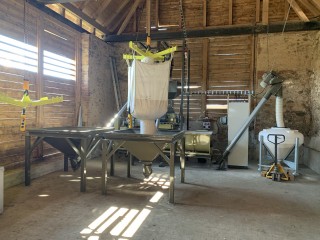
Miniature industrial feed mill in Mitrov, Czech (2t/hr)
Miniature industrial feed mill in Mitrov, Czech (2t/hr)
Budissa Days 2025
Budissa Days 2025Are you interested in our products or do you need more information?
Contact